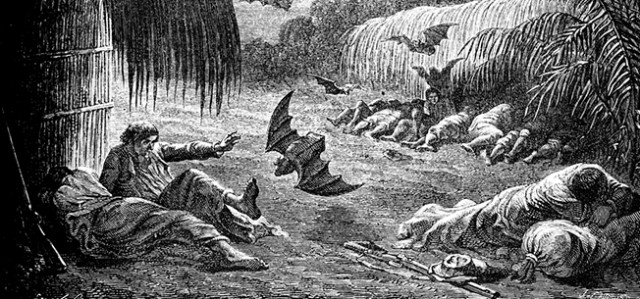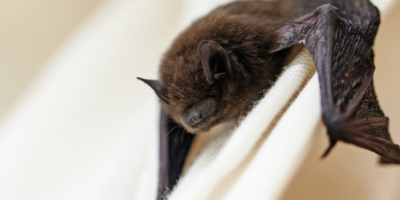It’s National Bat Week! Here’s 7 Common (But Old Timey) Bat Myths

Halloween is around the corner, and right now is the only time New Englanders like their homes to be decorated with these winged mammals. Ironically, having bats indoors is actually a lot more frightening of an idea for homeowners throughout the other 11 months of the year. Outdoors, however, they are one of the most beneficial animals on the planet! Nobody wants them in their attic, but as their numbers in North America dwindle, everybody should be concerned about this misunderstood pest’s ultimate survival.
Millions of bats across North America have died due to White-Nose Syndrome, a malicious and confusing disease that attacks hibernating bats with mortality rates of 100% at many sites. While a past experience with a bat in the attic may generate a favorable response to this, these endangered mammals desperately need people to reevaluate this sentiment.
We May Not Need Bats In Our Homes, But We Do Need Them
For those who like corn and other fresh crops, bats are a billion dollar asset. The agricultural industry relies heavily on what bats eat and what the rich fertilizer they excrete. These insectivorous animals, or animals that primarily feed on insects, are arguably the most prolific pest control experts in the United States. (Though we might argue that we give them a run for their money in New England.) They are globally important pollinators and seed dispersers whose survival is vital to healthy ecosystems.
So, before anybody reaches for a broom, let’s debunk some myths about these “scary” pests to help everyone understand why a bat problem should be handled by professionals who are intent on preserving their safety along with that of homeowners.
Myth #1: They’re Vampires
Not in North America. It is true that there are bat species that feed on blood, but they are all in Latin America. To lessen this fear even more, there are only 3 total vampire bat species (out of over 1,300) and only 1 targets mammals. The bats in New England attics are not going for the jugular, or near humans at all for that matter.
Myth #2: They’re Rabid
That’s just impossible. If bats were all infected with rabies, they wouldn’t be around to infect other animals by now. In fact, less than 1% of all bats are infected with the virus. Though one should be cautious around bats, there are telltale signs of a rabies infection. As mentioned above, bats generally steer clear of humans. If they aren’t doing so then they may be suffering from a rabies infection that renders them too sluggish to get away. So, bats are no more rabid than other mammals, but those that are will bite and should be avoided.
Myth #3: They’re Dirty
They aren’t rodents. A common misconception about bats is that they are “rodents with wings”. Bats are winged mammals that aren’t even in the same genetic order as rodents. The important difference here is that bats fly. Much like birds who preen themselves in order to fly without any hindrances, bats meticulously clean themselves (sometimes for hours).
Myth #4: They’re Blind
They can see better than humans. Their mastery of other sensory stimuli through echolocation has lead most people to believe that they “see” things via hearing them with their disproportionately large ears. Though this certainly helps, it isn’t their only advantage. As it turns out, they can see 3 times better than humans can. This means that they aren’t likely to accidentally fly into people.
Myth #5: They’re Stuck
Bats don’t nest at all, let alone in people’s hair. A particularly ridiculous myth is that bats get stuck in human heads of hair. We’ve already mentioned that they aren’t likely to fly near people in general, and they are far too agile to get stuck anywhere.
Myth #6: They’re Multiplying
Only one at a time. If homeowners have a bat infestation, it isn’t due to rapid reproduction. Bats only produce one single pup per litter, and only have 2-3 litters during the typical spring breeding season. This slow reproductive rate actually makes them more vulnerable to extinction than it does capable of rapidly infesting.
Myth #7: They’re Unlucky
Not in China. China is swarming with bats, from caves to the art that defines their culture. The Chinese symbol for bat is the same as that of good fortune.
Conserving Bat Populations While Protecting Homeowner Safety
JP Pest Services recognizes the importance of bats in our ecosystem, but we also recognize the safety concerns of New England homeowners experiencing a bat issue.. Bats should be preserved, but not in the attics of our customers. Our licensed and professionally trained Service Professionals use one-way excluder doors in the exclusion process. These doors enable bats to leave the structure but do not allow re-entry. Because bats are easily able to find new places to dwell, they’re able to be successfully relocated back into their natural environment. Contact us today if you have bats that aren’t just halloween decorations.



